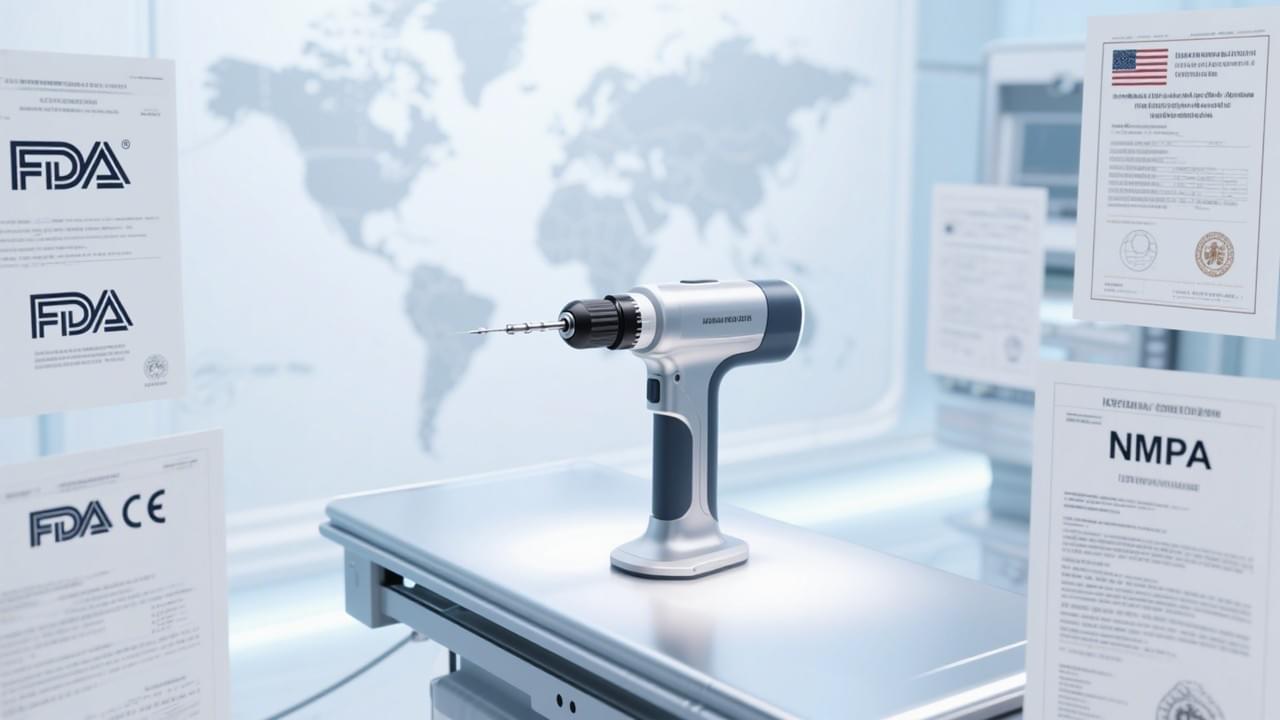In today’s interconnected medical device market, international regulations for orthopedic power tools are more than just bureaucratic checkboxes—they’re essential for patient safety, brand trust, and market access. Whether you’re launching a new surgical drill or expanding into overseas markets, knowing the rules can be the difference between success and a costly recall.
Let’s break down the seven must-know regulatory standards across the U.S., Europe, and Asia—and what they mean for your orthopedic product line.
Table of Contents
Toggle1. FDA Regulations: A Closer Look at U.S. Requirements
The FDA orthopedic power tools requirements fall under Class II devices, requiring a 510(k) premarket notification. This submission proves that your tool is substantially equivalent to a legally marketed device.
To comply, you must:
- Conduct electrical safety testing (IEC 60601).
- Provide human factors analysis.
- Submit robust technical documentation.
Also, don’t overlook labeling and UDI (Unique Device Identifier) standards, which are non-negotiable for FDA clearance.
2. MDR: EU’s Stricter CE Marking Standards
The European Union’s Medical Device Regulation (MDR) is possibly the strictest in the world. If you’re targeting Europe, securing CE marking for surgical drills requires a conformity assessment by a Notified Body.
Key needs include:
- Clinical evaluation reports.
- Risk management documentation.
- Periodic Safety Update Reports (PSURs).
These steps ensure your product aligns with EU safety and performance standards—and stays on the market legally.
3. NMPA: Understanding China’s Regulatory Process
For companies eyeing the Chinese market, NMPA medical device certification China involves a complex and highly localized process.
Here’s what to expect:
- Local type testing in NMPA-approved labs.
- Full translation of technical documents into Simplified Chinese.
- Registration through a licensed China agent.
Unlike other regions, the NMPA mandates clinical trial data or justifications for exemption, even for products cleared in the U.S. or EU.
4. Common Global Regulatory Requirements
No matter the country, most jurisdictions require:
- Accurate device classification (risk-based).
- A well-structured technical file, including design specs and risk analysis.
- Evidence of biocompatibility and sterilization validation.
Even emerging markets like Brazil and India expect alignment with international ISO standards, especially ISO 13485.
5. Unique Device Identification (UDI) Trends
UDI isn’t just a barcode—it’s a global traceability tool. Whether you’re registering with the FDA’s GUDID or Europe’s EUDAMED, each region has specific formatting and reporting timelines.
Pro tip: Incorporate UDI planning into the design stage to avoid costly retrofitting later.
6. Post-Market Surveillance & Reporting
International law now demands that manufacturers monitor device performance after launch.
You’ll need to:
- Report adverse events (15 days in EU, 30 in China).
- Maintain a Post-Market Clinical Follow-up (PMCF) plan.
- Update safety records annually.
Skipping this can trigger fines, recalls, or even market suspension.
7. Overcoming Cross-Border Challenges
Each region defines and classifies devices differently, which often leads to confusion. A tool classified as Class I in the U.S. may be Class IIb in the EU.
Best practices:
- Engage early with regulatory consultants in target markets.
- Develop a master file with localized annexes.
- Always test your tool under local electrical and EMC standards.
🧪 Case in Point: Launching a Drill Globally
One mid-size manufacturer recently launched a powered surgical drill in the U.S., EU, and China. They faced:
- 5-month FDA 510(k) wait time.
- 9-month CE mark application under MDR.
- 12-month NMPA process due to local testing delays.
The secret to success? A unified regulatory strategy with strong local partnerships.
🧭 Smart Tips for Manufacturers
- Start regulatory planning in R&D—not after development.
- Include local labeling, translations, and symbols in packaging.
- Allocate budget for country-specific testing (especially in China and Brazil).
Master the Maze, Secure Your Market
Navigating international regulations for orthopedic power tools may seem overwhelming, but the payoff is worth it. A compliant, well-documented product not only meets legal demands but also wins the trust of surgeons, hospitals, and global distributors.
Invest in compliance now—and save millions in penalties, delays, or worse, a product recall.

